
Steve McCaa awaits the start of the 2013 Iron Butt Rally.
Under a light but steady drizzle, 96 competitors (six of them riding two-up) streamed out of the parking lot of a Marriott hotel north of Pittsburgh this morning to begin the unique odyssey of the 2013 Iron Butt Rally. Over the next 11 days, they’ll criss-cross the continent in search of bonus points while still trying to get to checkpoints on time.
History suggests that the top finishers will average more than 1,000 miles a day, about what some garage-queen motorcycles get ridden per year. History also suggests about 25 percent of those who start won’t make it to the finish, and even more cruelly, some of them may reach the finish on time but without enough bonus points to qualify as an official finisher.
Read the followup:
Cruelty, thy name is IBR
Abandon all hope of normal sleep patterns, all ye who enter the Iron Butt Rally. And don’t bother trying to explain your need to compete to non-riders. Don’t even try to explain it to most people who do ride. Some human endeavors just don’t conform to normal notions of sense and logic.
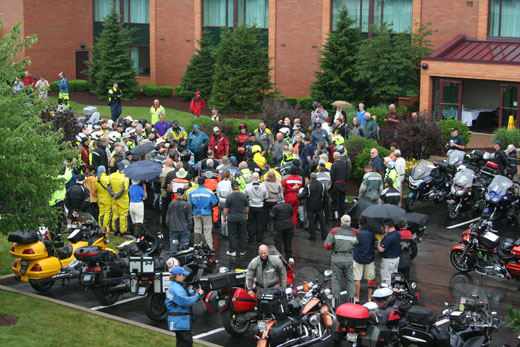
The riders meeting before the start.
Just qualifying for and getting into the rally is a challenge. This year’s field includes a mix of veterans and IBR rookies, though even the rookies are experienced long-distance riders. I earlier wrote about one of them, Steve McCaa (shown above), who is riding the first-ever Kawasaki Versys in the Iron Butt Rally. That puts him in a rare sort of middle ground. Usually the entire field in the Iron Butt Rally, from the top riders who expect to contend for the win to those who just hope to finish, are mounted on liter-plus sport-touring and touring bikes. The exceptions are the entrants in what the rally calls the “Hopeless Class,” riders who talk their way into the rally and plan to ride bikes not ideally suited to the task at hand.
McCaa’s Versys is neither: Not from the list of bikes that conventional wisdom suggests, such as a Honda Gold Wing or ST1300, a Yamaha FJR1300, a Kawasaki Concours 14, or one of the wide range of BMW oil-head boxers or K bikes you’ll see on the starting line. But it’s far from the Hopeless Class, too. McCaa has equipped his Versys with the multiple GPS units, wind protection, comfortable seat, auxiliary fuel tank and extra lighting that the other serious competitors are using. He just decided to start the rally with about half as many cubic centimeters of engine displacement and a lot less weight.
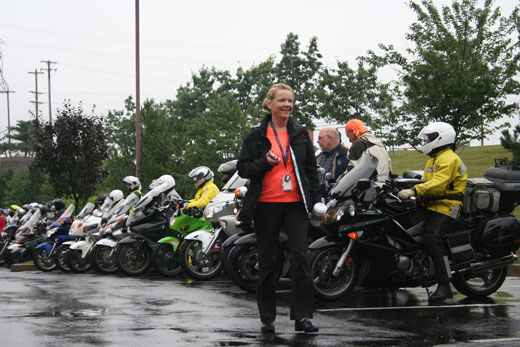
Rallymaster Lisa Landry reviews the troops before the start.
This year’s Hopeless Class deserves a mention. It always does. Among all the huge bikes bristling with technology and extra fuel sat one that looked like a toy in that oversized company. Kurt Worden’s Kawasaki Ninja 250 had no extra fuel, no high-tech LED lights that could burn the hide off a road-crossing deer at 100 paces. Just a simple set of throw-over soft saddlebags and a determined rider. Even further off the wall was Robert Koeber’s 1986 Honda XBR 500, an air-cooled single already well into six-figure mileage and shipped in from Europe for the competition.
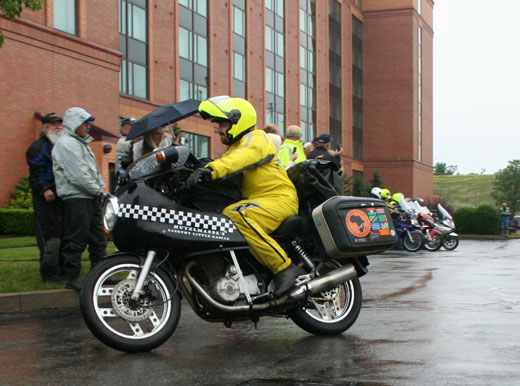
Robert Koeber starts the IBR on a 27-year-old air-cooled single.
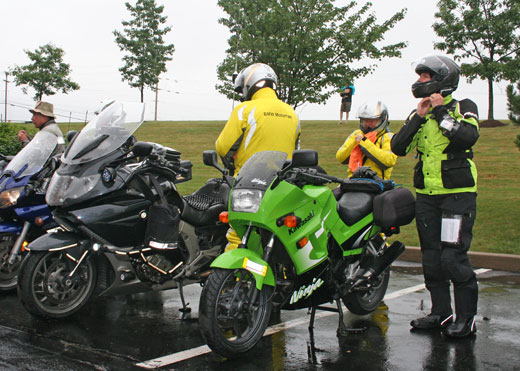
IBR extremes: Two-up on a six-cylinder BMW luxury yacht and a man alone with his bare-bones Ninja 250.
One twist for this year’s rally is that many of the bonus point sites are “daylight only,” which may encourage riders to get some sleep and reduce risk a little. The first checkpoint for all the riders is back at the same Marriott north of Pittsburgh on July 4. Then the next checkpoint is in Sacramento, just 65 hours later. That leaves little time for detouring to pick up bonus points as they ride west. Then they return to Pittsburgh for the finish.
Bob Higdon has returned to his old task of writing daily updates about the rally, which means those of us watching from home will have highly entertaining accounts of what’s happening as the riders scatter about the continent. Read them here. Another feature this year is that we can follow the riders via SpotWalla. See the map here.
As always, the rally won’t be won by the brand of bike or the kind of accessories, but by the rider who makes the fewest mistakes. Some riders, tired and confused, will lose receipts, make a foolish routing decision, forget what time zone they’re in and miss a checkpoint deadline or commit some other error under the strain.
Then afterwards they’ll try to explain, to themselves and others, how they made such rookie mistakes. But as we’ve already stipulated, it’s hard to explain the Iron Butt Rally.
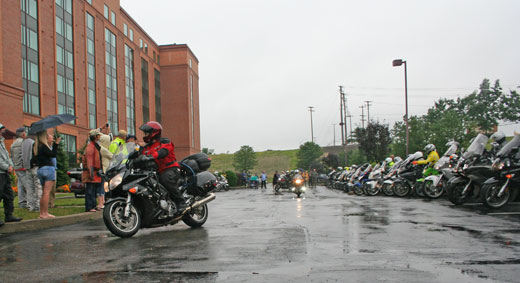
Dave Hembroff, whose day job is road riding director for the AMA, starts the rally on his FJR1300.
